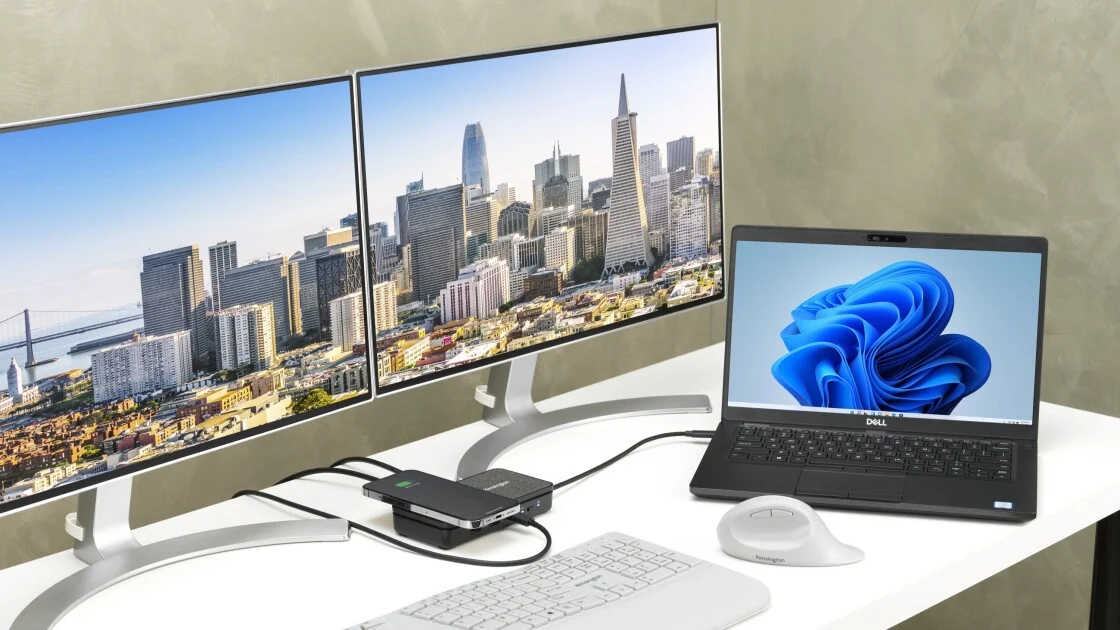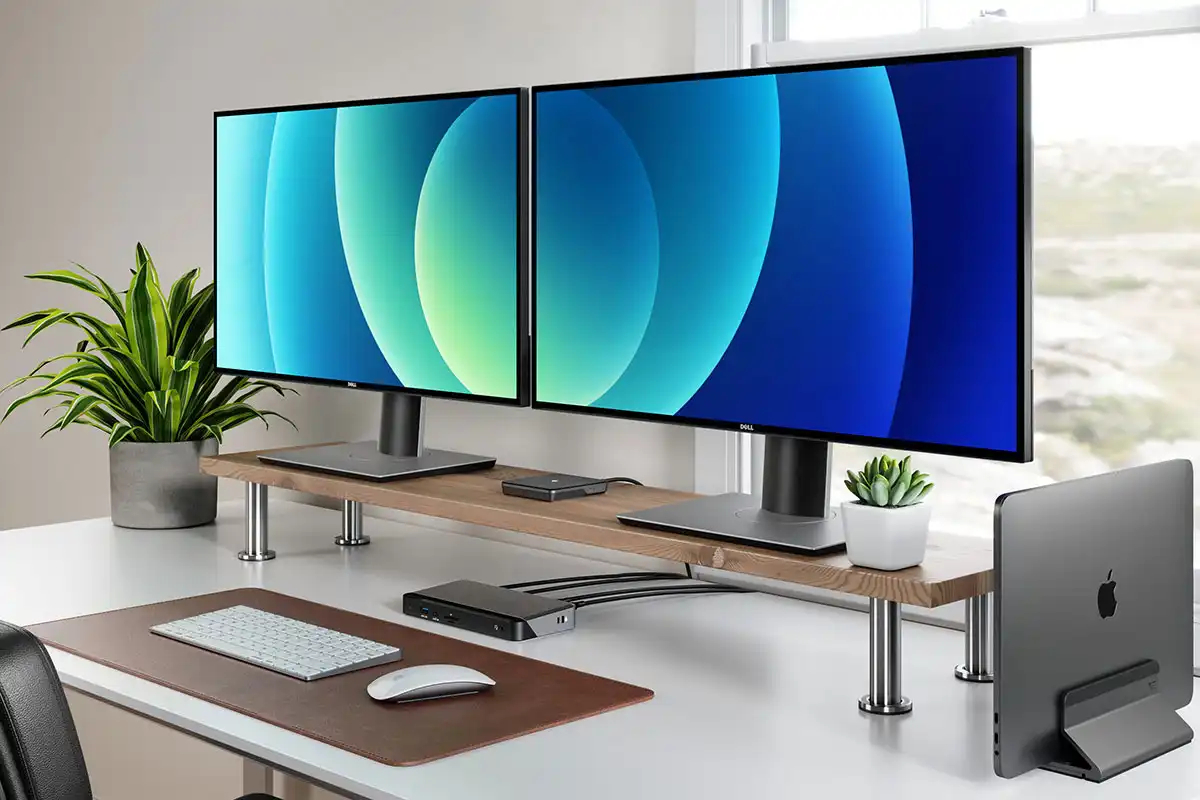The Rise of Dual Monitor Workstations
The Increasing Demand for Enhanced Productivity
In today’s fast-paced digital landscape, the ability to multitask and access multiple applications simultaneously has become an essential component of productivity. This has led to the growing popularity of dual monitor setups, which provide users with an expanded digital workspace and improved workflow efficiency.
The Challenges of Connecting Multiple Devices
While the benefits of dual monitor configurations are well-established, the physical and technical challenges of connecting and managing multiple displays and peripherals can be daunting, particularly for users with limited desk space or technical expertise.
The Role of Dual Monitor Docking Stations
Simplifying the Dual Monitor Setup
Dual monitor docking stations have emerged as a solution to address the complexities of integrating multiple displays and devices into a cohesive and user-friendly workspace. These docking stations streamline the connection process and provide a centralized hub for managing the various components of a dual monitor setup.
Enhancing Productivity and Efficiency
By seamlessly connecting dual monitors, keyboards, mice, and other peripherals through a single docking station, users can enjoy a streamlined and efficient computing experience, enabling them to focus on their tasks without the hassle of tangled cables or multiple connection points.

Key Features of Dual Monitor Docking Stations
Dual Monitor Support
The primary function of a dual monitor docking station is to enable the simultaneous connection and operation of two displays, providing users with an expanded workspace and the ability to multitask more effectively.
Connectivity Options
Dual monitor docking stations typically offer a range of connectivity ports, such as HDMI, DisplayPort, USB, Ethernet, and audio, allowing users to connect a wide variety of devices and peripherals to their workstation.
Charging and Power Delivery
Many dual monitor docking stations incorporate power delivery capabilities, enabling them to charge connected laptops or other devices, further simplifying the overall setup and reducing the need for additional power adapters.

Choosing the Right Dual Monitor Docking Station
Display Resolution and Refresh Rate Support
When selecting a dual monitor docking station, it’s essential to ensure compatibility with the desired display resolutions and refresh rates to provide a seamless and high-quality visual experience.
Laptop and Device Compatibility
Compatibility with the user’s specific laptop or other devices is a crucial consideration, as not all docking stations may be compatible with every make and model.
Additional Features and Functionality
Depending on individual needs and preferences, users may also want to evaluate dual monitor docking stations with additional features, such as built-in Ethernet connectivity, USB-C or Thunderbolt 3 support, or the ability to accommodate more than two displays.

Setting Up a Dual Monitor Docking Station
Physical Installation and Positioning
Properly positioning the dual monitor docking station and arranging the displays in an ergonomic and visually appealing manner can contribute to a comfortable and efficient work environment.
Driver and Software Installation
Ensuring that the necessary drivers and software are installed correctly is essential for the docking station and connected displays to function seamlessly.
Cable Management and Organization
Effective cable management solutions, such as built-in cable routing or concealment features, can help maintain a clean and organized workspace.

Optimizing the Dual Monitor Docking Station Setup
Display Settings and Calibration
Adjusting the display settings, including resolution, color profiles, and window management. Can help ensure a consistent and visually appealing dual monitor experience.
Customizing the Operating System
Leveraging the operating system’s built-in tools and settings for managing dual monitor configurations can further enhance the user’s workflow and productivity.
Integrating with Productivity Apps and Software
Certain productivity-focused applications or software may offer features or integrations specifically designed to optimize the monitor setup. Enabling users to take full advantage of the expanded workspace.
Maintenance and Troubleshooting
Firmware and Driver Updates
Regularly checking for and installing any necessary firmware or driver updates can help ensure the continued reliable performance of the dual monitor docking station and its connected devices.
Addressing Connection Issues
In the event of any connection problems or display-related issues. Users should refer to the manufacturer’s troubleshooting guides or seek professional assistance to resolve the problem effectively.
Proper Cleaning and Care
Regularly cleaning the docking station and its ports, as well as ensuring proper ventilation. Can help maintain the device’s longevity and optimal performance.
The Future of Dual Monitor Docking Stations
Integration with Emerging Technologies
As display technologies, connectivity standards, and device ecosystems continue to evolve, dual monitor docking stations may become increasingly integrated with emerging trends, such as the growth of remote work, the rise of virtual and augmented reality, and the increasing prevalence of smart home and IoT (Internet of Things) systems.

Advancements in Functionality and Versatility
Future developments in dual monitor docking station design and engineering may lead to even more versatile and feature-rich solutions. Incorporating capabilities like wireless charging, advanced cable management systems, or the ability to support more than two displays.
Seamless Workflow Enhancements
Continued software and operating system integration may result in even more seamless. And intuitive workflow enhancements for users with dual monitor docking station setups. Enabling them to better manage their digital workspaces and streamline their productivity.
Conclusion
Dual monitor docking stations have emerged as a transformative solution for unlocking the full potential of dual monitor workstations. By simplifying the connection and management of multiple displays and peripherals. These docking stations empower users to create efficient and ergonomic computing environments that maximize their productivity and workflow. As the demand for optimized digital workspaces continues to grow. The importance of dual monitor docking stations is poised to increase. Making them an essential component in the evolving landscape of modern computing and remote work. With their ability to adapt to emerging technologies and user needs. These docking stations are set to play a crucial role in shaping the future of how we interact with and optimize our digital environments. More than just a simple connectivity solution. These docking stations contribute to enhanced productivity, improved ergonomics, and a more organized work environment. As display technologies and device ecosystems continue to evolve. The role of dual monitor docking stations will only grow in importance. Solidifying their position as an indispensable tool in the modern digital landscape.